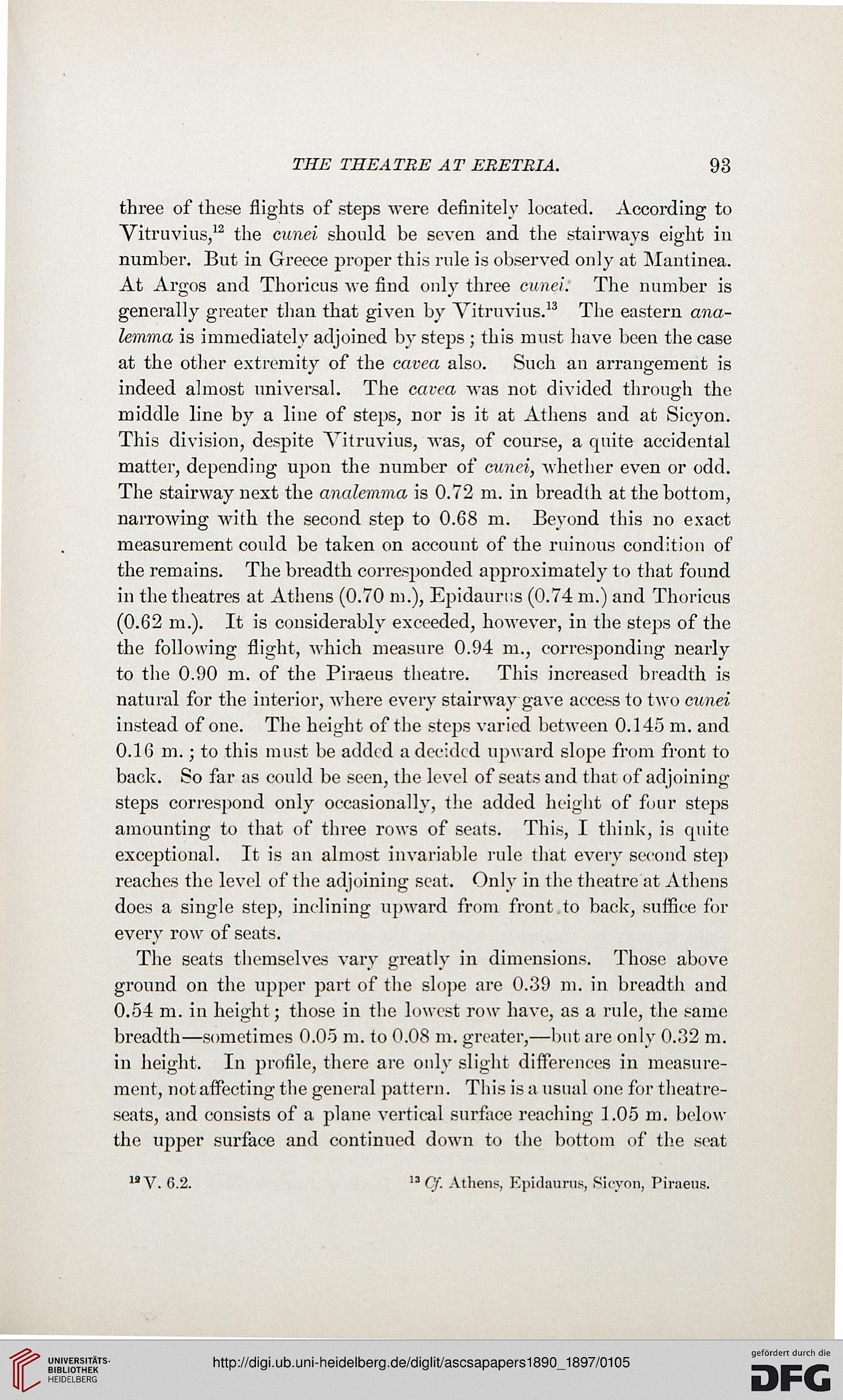THE THEATRE AT ERETRIA.
93
three of these flights of steps were definitely located. According to
Vitruvius,12 the cunei should be seven and the stairways eight in
number. But in Greece proper this rule is observed only at Mantinea.
At Argos and Thoricus we find only three cunei: The number is
generally greater than that given by Vitruvius.13 The eastern ana-
lemma is immediately adjoined by steps ; this must have been the case
at the other extremity of the cavea also. Such an arrangement is
indeed almost universal. The cavea was not divided through the
middle line by a line of steps, nor is it at Athens and at Sicyon.
This division, despite Vitruvius, was, of course, a quite accidental
matter, depending upon the number of cunei, whether even or odd.
The stairway next the analemma is 0.72 m. in breadth at the bottom,
narrowing with the second step to 0.68 m. Beyond this no exact
measurement could be taken on account of the ruinous condition of
the remains. The breadth corresponded approximately to that found
in the theatres at Athens (0.70 m.), Epidaurus (0.74 m.) and Thoricus
(0.62 m.). It is considerably exceeded, however, in the steps of the
the following flight, which measure 0.94 m., corresponding nearly
to the 0.90 m. of the Piraeus theatre. This increased breadth is
natural for the interior, where every stairway gave access to two cunei
instead of one. The height of the steps varied between 0.145 m. and
0.16 m.; to this must be added a decided upward slope from front to
back. So far as could be seen, the level of seats and that of ad joining-
steps correspond only occasionally, the added height of four steps
amounting to that of three rows of seats. This, I think, is quite
exceptional. It is an almost invariable rule that every second step
reaches the level of the adjoining seat. Only in the theatre at Athens
does a single step, inclining upward from front , to back, suffice for
every row of seats.
The seats themselves vary greatly in dimensions. Those above
ground on the upper part of the slope are 0.39 m. in breadth and
0.54 m. in height; those in the lowest row have, as a rule, the same
breadth—sometimes 0.05 m. to 0.08 m. greater,—but are only 0.32 m.
in height. In profile, there are only slight differences in measure-
ment, notaffecting the general pattern. This is a usual one for theatre-
seats, and consists of a plane vertical surface reaching 1.05 m. below
the upper surface and continued down to the bottom of the seat
"V. 6.2.
13 Cf. Athens, Epidaurus, Sicyon, Piraeus.
93
three of these flights of steps were definitely located. According to
Vitruvius,12 the cunei should be seven and the stairways eight in
number. But in Greece proper this rule is observed only at Mantinea.
At Argos and Thoricus we find only three cunei: The number is
generally greater than that given by Vitruvius.13 The eastern ana-
lemma is immediately adjoined by steps ; this must have been the case
at the other extremity of the cavea also. Such an arrangement is
indeed almost universal. The cavea was not divided through the
middle line by a line of steps, nor is it at Athens and at Sicyon.
This division, despite Vitruvius, was, of course, a quite accidental
matter, depending upon the number of cunei, whether even or odd.
The stairway next the analemma is 0.72 m. in breadth at the bottom,
narrowing with the second step to 0.68 m. Beyond this no exact
measurement could be taken on account of the ruinous condition of
the remains. The breadth corresponded approximately to that found
in the theatres at Athens (0.70 m.), Epidaurus (0.74 m.) and Thoricus
(0.62 m.). It is considerably exceeded, however, in the steps of the
the following flight, which measure 0.94 m., corresponding nearly
to the 0.90 m. of the Piraeus theatre. This increased breadth is
natural for the interior, where every stairway gave access to two cunei
instead of one. The height of the steps varied between 0.145 m. and
0.16 m.; to this must be added a decided upward slope from front to
back. So far as could be seen, the level of seats and that of ad joining-
steps correspond only occasionally, the added height of four steps
amounting to that of three rows of seats. This, I think, is quite
exceptional. It is an almost invariable rule that every second step
reaches the level of the adjoining seat. Only in the theatre at Athens
does a single step, inclining upward from front , to back, suffice for
every row of seats.
The seats themselves vary greatly in dimensions. Those above
ground on the upper part of the slope are 0.39 m. in breadth and
0.54 m. in height; those in the lowest row have, as a rule, the same
breadth—sometimes 0.05 m. to 0.08 m. greater,—but are only 0.32 m.
in height. In profile, there are only slight differences in measure-
ment, notaffecting the general pattern. This is a usual one for theatre-
seats, and consists of a plane vertical surface reaching 1.05 m. below
the upper surface and continued down to the bottom of the seat
"V. 6.2.
13 Cf. Athens, Epidaurus, Sicyon, Piraeus.




